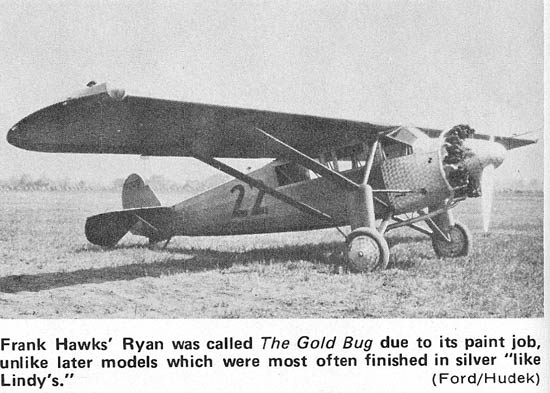Frank M. Hawks, ca. 1931
(Source: NASM)
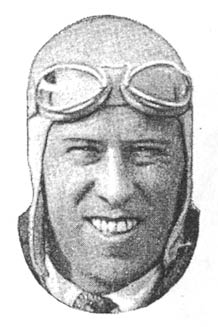 |
Frank Hawks was born March 28, 1897 at Marshalltown, IA. He
died on August 23, 1938 when a Gwinn Aircar he was flying
struck power lines and crashed at East Aurora, NY (follow
this link to
see an image of the Gwinn Aircar on this site). See Nancy Harkness for two images of her with Hawks and the Aircar.
He
learned to fly at 18. He packed 214 point-to-point
aviation records in his 23-year flying career. Do the
math.
After finishing high school Hawks became interested in flying
when a barnstormer came to town. The price for a flight
was $25, but Hawks posed as a news reporter and went up for
nothing. He came clean and became “ground crew” for
the ship. A short biography in Popular Aviation, June, 1931 describes his first flight and the attack of conscience that made him come "clean." The article is downloadable at the link (PDF 870Kb).
He attended the University of California for two years and
left to join the air service in hope of serving overseas. He
did not. Rather, he was detailed instead as an instructor
at Love Field, TX. He retired from the army with the
rank of captain, then barnstormed over the country, flew
mail and payrolls and stunted with air circuses.
Hawks landed once at Tucson on June 6, 1927 flying a Ryan
B-1 Brougham, NC3009. He carried a single passenger, D.W.
Campbell. Based in Houston, TX, they were eastbound from San Diego, CA to Houston and then on to Washington, DC. They
wrote in the Remarks column of the Register, "Enroute
to Washington". He was also inspected by the U.S. Border Patrol. in the Remarks column also appears the annotation, "Frank C. Fitch Patrol Inspector." Fitch is pictured at the link.
The Ryan they were flying was used by Hawks in the 1927
Ford Reliability Tour. The Tour that year did not pass through
Tucson, although the 1928
Tour did. Hawks participated in that Tour also flying
Texaco's Ford trimotor NC3443, Tour #2. While Hawks did not sign the Register when he visited with NC3443, we know he was there because of a motion picture film. Follow this link to
see the film of the 1928 Tour landing at Tucson.
You will see Hawks' Ford Trimotor just briefly, and be able
to note the registration number, NC3443, under the left wing. Technically, then, Hawks landed at Tucson at least twice (but see his glider experience, below).
Below is an image
of the Ryan in 1927 Tour livery (#22). Hawks and his passengers
(among them his wife) placed 8th in the event that took place
June 27-July 12, 1927. It is easy to believe the flight during
which he signed the Register at Tucson was a ferry east in
preparation for the Tour. Image from page 58 of Forden's
unique and useful reference in the left sidebar.
Hawks acquired fame in February, 1929 when he flew the Lockheed Air
Express NC7955 from Los Angeles to New York non-stop in 18 hrs.
21 min. 59 sec. That
was the fastest transcontinental time to-date. This flight was documented in article in Popular Aviation magazine, May, 1929, available at the link (PDF 1.0Mb). Later
he flew the 2,700 miles from NY to LA non-stop in 19 hours
and returned to NY the next day in 17 hrs. 36 min., breaking
his previous record.
Below, courtesy of site visitor Joe Kranz, a U.S. postal cachet commemorating the 1929 National Air Races. It is dated August 31, 1929.
U.S. Postal Cachet, August 31, 1929 (Source: Kranz)
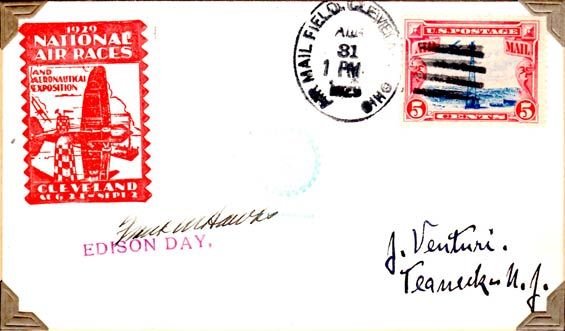 |
Popular Aviation, June, 1931 (Source: PA)
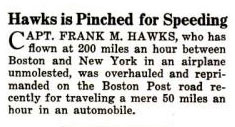 |
In August 1930, in a Beech Mystery Ship named "Texaco
13",
Hawks flew east-west in 14 hrs. 50 min. 3 sec. and west-east
in 12 hr. 25 min. 3 sec., beating his own 1929 records. Both
flights were made with intermediate fuel stops. Alluding to those flights, the article at right from Popular Aviation (PA) cites a minor brush with the law.
An image of him during his Texas Company tenure is in the Charles Cooper Photograph and Document Collection. Another is below, shared with us by site visitor J. Carroll. This beautiful photograph was signed by Hawks and presented to her grandfather in 1933.
Frank Hawks, May 23, 1933 (Source: Carroll)
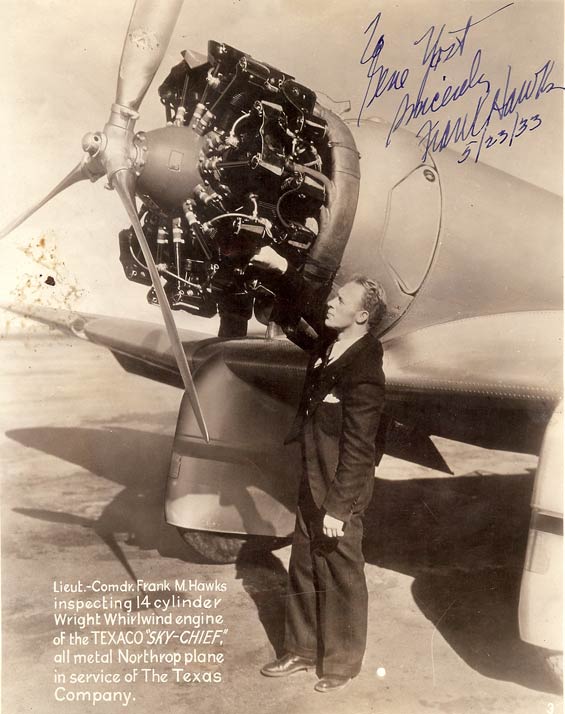 |
Earlier, he carried this cachet as part of his participation in the Third Annual Miami All-American Air Races held at Miami, FL in 1931. The cachet is shared with us by site visitor Jeff Staines.
U.S. Postal Cachet, January 8, 1931 (Source: Staines)
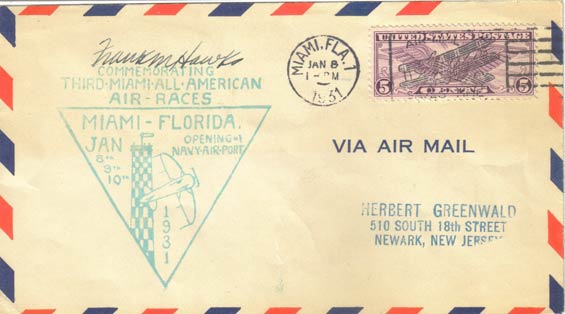 |
Frank Hawks is well represented on the Web,
with over 750 Google hits as of the upload date of this page. Because
of this, I choose to illustrate his flying life via links
to information that already exists, rather than reinventing
the wheel here. For a general biography, refer to this
link.
In April 1930, Hawks, with pilot J.D. Jernigan, Jr., flew
through Tucson with Jernigan towing Hawks in the “Texaco
Eaglet” glider. That flight, with a photograph
of both the glider and tow plane, is summarized here. Neither
Hawks nor Jernigan signed the Register when they landed at
Tucson April 1.
Further to the glider flight, an interesting aside is the letter, below, shared by Mr. Staines. He states about this letter, "This letter is signed by DM visiting-but-not-signing pilot J. D. Jernigin, ( Who had glider pilot Frank M.Hawks in tow back in 1930 ) on Texas Company stationery dated May 3, 1932. He was responding to Aviation Autograph Hound and Airmail Cover Collector Bart A. Brady's request for photographs. In 1932, Jernigin was Superintendent of Aviation for the Texaco Sales Department in New York."
Letter of Request, May 3, 1932 (Source: Staines)
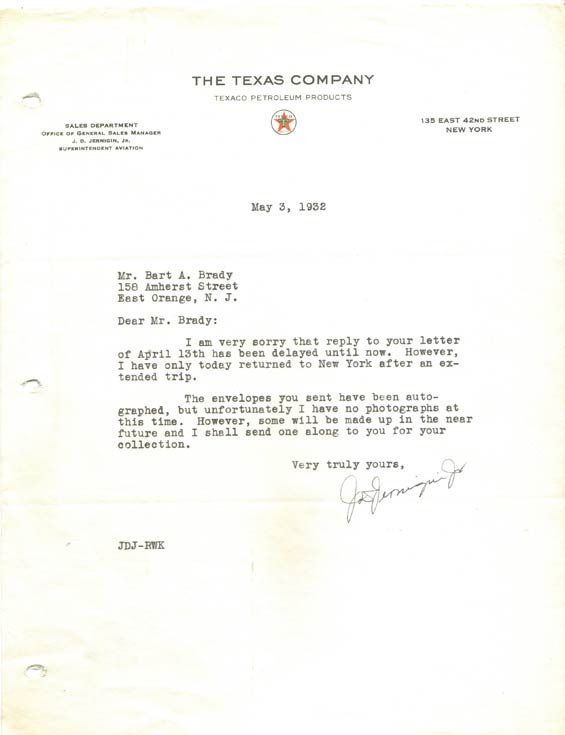 |
A 15-minute moving picture film of early Lockheed history
is available here. Frank
Hawks is shown very briefly entering a cockpit. What’s
interesting about this film clip is that other Davis-Monthan
Register pilots are shown, including Art
Goebel, Amelia Earhart, Ruth
Nichols and Charles Lindbergh.
Good technical and operational information on the Gwinn
Aircar is available here. Below is a description of the Gwinn Aircar from Popular Aviation (PA) magazine, November, 1937.
Gwinn Aircar, Popular Aviation, November, 1937 (Source: PA)
 |
Below, also from site visitor Kranz, a news article citing Hawks' crash with the Gwinn Aircar.
Hawks Crash, August 24, 1938, News Source Unknown (Source: Kranz)
 |
Continuation...
Hawks Crash, August 24, 1938, News Source Unknown (Source: Kranz)
 |
Another account of the accident appeared in the North Adams Transcript (MA) of August 24, 1938, below. Photos with this article (low quality) showed the extent of the fire and destruction of the Aircar.
FRANK HAWKS DIES IN FLAMING PLANE.
WORLD FAMOUS SPEED FLIER AND PASSENGER KILLED WHEN PLANE HITS WIRES TAKING OFF NEAR BUFFALO, N.Y.
HOPED TO RETIRE.
Buffalo, N.Y., Aug. 24 (AP) -- Death came last night to Lieut. Commander FRANK M. HAWKS, world famous speed flier, as he had predicted -- in an airplane.
The 41-year-old aviator who had turned a year ago from speed flying to the aviation business struck some wires and crashed in flames on a polo field a few miles from Buffalo.
HAWKS, who told a friends some years ago "I expect to die in an airplane," and J. HAZARD CAMPBELL, upstate socialite and sportsman who had accepted an invitation for a trial spin in a small plane HAWKS company sells, were fatally injured.
Horrified friends, who had watched the take-off from the small field, heard the plane crash behind a clump of trees. They saw a flash as flames shot high in the air.
They pulled HAWKS from the controls of the blazing ship and dragged CAMPBELL from beneath a crumpled wing. The injured men were taken to a Buffalo hospital in ambulances. Neither regained consciousness.
HAWKS was flying a small Gwinn Aircar, a plane designed for private flying. He carried a four leaf clover a friend had given him for "good luck" a few minutes before the take-off.
Edmund P. Rogers, from whose estate HAWKS and CAMPBELL took off, described the crash:
"Commander HAWKS landed on our field about 5 p.m. and offered to take myself or any of our guests for a ride. CAMPBELL climbed in first."
"The plane lifted in the air and HAWKS tilted it 50 feet above the ground to enable it to pass between two tall trees. As he passed out of sight it looked as though he had not been able to gain sufficient altitude and was trying to bring the plane down."
"Just as the plane disappeared we heard a loud crash and a flash of flame shot up behind the trees. We knew he had struck the electric wires and telephone poles."
"We ran to the plane and found HAWKS inside the burning machine on the seat. His clothes were on fire so we stripped him and pulled him away."
Rogers said CAMPBELL was thrown from the plane and pinned under a crumpled and blazing wing. The crash had ripped down all telephone and light wires serving the community and Rogers and his friends had to go several miles to summon aid.
HAWKS was vice president in charge of sales for the Gwinn Aircar corporation. Joseph M. Gwinn, president, said HAWKS had been making demonstration flights for the company during the past year.
HOPED TO QUIT FLYING.
New Canaan, Ct., Aug. 24 (AP) -- FRANK HAWKS dreamed of deserting flying as a profession for writing.
In an article published posthumously in the current issue of the Connecticut Nutmeg, a periodical published by a group of literary celebrities for their own amusement HAWKS wrote:
"I have always wanted to be a writer, to rub shoulders with the intelligentsia."
The famous aviator, killed in an airplane crash last night near Buffalo, N.Y., expressed the hope that he could one day give up flying and take up writing as a career.
The article, entitled "Birds Land, Aviators Alight," describes the "air car" he was piloting at the time of his death as "so fool proof it is not subject to the dangerous tendencies of the conventional airplane."
"It will not spin and it will not stall," HAWKS said.
Speaking of the birds in relation to human fliers, he wrote: "Birds are the only ones who know where they are going. They are the only ones who never fail to make a perfect landing. They are the only ones who have sense enough to stay on the ground or on their perches when the ceiling is zero-zero, or a bad storm is in the air."
"Aviators will barge into the sky when the birds are afraid to walk; and do aviators always land perfectly or at the destination to which they started; they do not." |
News coverage and an obituary in Time Magazine is at the link.
As mentioned above, he participated in the 1928 Ford National
Reliability Tour. Tour planes descended on Tucson during
the late morning of July 10. You may see a film clip on this
Web site of that activity here.
Hawks flew other aircraft, with other pilots of the Register.
See especially NC7162, Walter
Beech, Hub Fahey and James
Dickson. The Davis-Monthan Airfield Register reveals
a tight "club" of Golden Age aviators. Hawks landed a total of eight times to sign our Registers. Besides the Davis-Monthan Register (landed once), he is represented in the Parks Field (5 landings) and Peterson Field (two landings) Registers.
---o0o---
Dossier 2.1.96
THIS PAGE UPLOADED: 05/15/07 REVISED: 02/13/08, 03/01/11, 04/09/11, 07/01/11, 07/08/11, 05/01/12, 07/01/14, 07/31/14, 06/20/16
|



